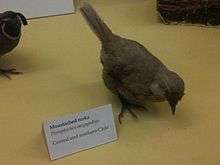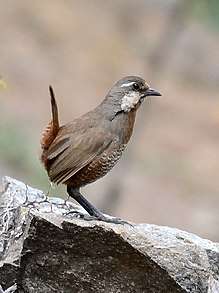Moustached turca
| Moustached turca | |
|---|---|
 | |
| Scientific classification | |
| Kingdom: | Animalia |
| Phylum: | Chordata |
| Class: | Aves |
| Order: | Passeriformes |
| Family: | Rhinocryptidae |
| Genus: | Pteroptochos |
| Species: | P. megapodius |
| Binomial name | |
| Pteroptochos megapodius Kittlitz, 1830 | |

The moustached turca (Pteroptochos megapodius) is a passerine bird which is endemic to Chile. It belongs to the tapaculo group and is a member of the genus Pteroptochos, along with the two species of huet-huet.
It is a stocky bird, 23–24 cm long, with a heavy bill and strong legs and feet. The tail is often held cocked. The plumage is mostly brown with white barring on the breast, belly and undertail-coverts. The bird has a dark eyestripe, white eyebrow and a broad white moustachial stripe. The bill and legs are black. The northern race atacamae is smaller and paler with less obvious barring on the underparts.
The song is a series of low, hooting notes lasting for 5 to 10 seconds. Birds often call while perched on top of a rock.
The nominate subspecies is found in central Chile from northern Bío-Bío Region north to Coquimbo Region. The isolated form atacamae occurs in Atacama Region. Both inhabit arid slopes with rocks and shrubbery from sea-level to high in the foothills of the Andes, reaching 3700 metres in the north. It is a mainly ground-dwelling bird which can run quickly. It feeds on invertebrates such as insects and worms.
The nest is built at the end of a tunnel up to two metres long which is dug in an earth bank or roadside cutting. Two or three white eggs are laid.
References
- ↑ BirdLife International (2012). "Pteroptochos megapodius". IUCN Red List of Threatened Species. Version 2013.2. International Union for Conservation of Nature. Retrieved 26 November 2013.
- Jaramillo, Alvaro; Burke, Peter & Beadle, David (2003) Field Guide to the Birds of Chile. Christopher Helm, London.
- Aves de Chile: Moustached Turca
